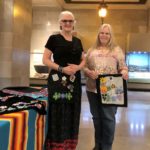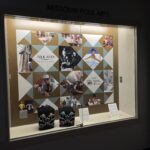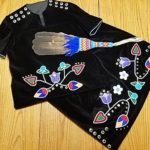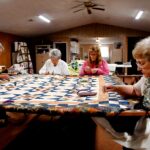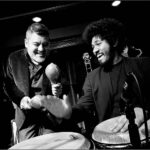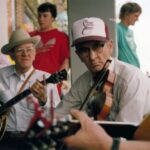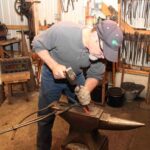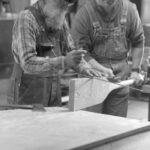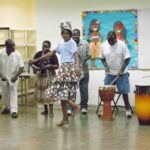2019 TRADITIONAL ARTS APPRENTICESHIP PROGRAM: PEGGY KINDER AND CINDY JARRAR
Meet Peggy Kinder and her 2019 apprentice Cindy Jarrar, enrolled members of the Citizen Potawatomi Nation, who reside in Clay County, Missouri.
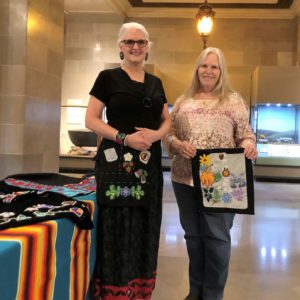
Peggy Kinder and Cindy Jarrar display small applique beadworks at Folk Arts at the Capitol in Jefferson City, Mo. Photo by Deborah A. Bailey
Since 2011, Peggy Kinder has taught in the Traditional Arts Apprenticeship Program three times helping her apprentices to strengthen their skills and knowledge of applique ribbonwork, shawl fringe tying, and now applique beadwork. Each is a tradition that Kinder observed and began learning at an early age. “My family and extended family were traditional people, and they instilled in me a deep love and respect for our heritage and our arts.”

Traditional clothing made by Peggy Kinder. Photo courtesy of Citizen Potawatomi Nation
With their applique beadwork apprenticeship, Kinder is teaching Jarrar a very specific Woodland tradition, one that reflects the flora and fauna of the Potawatomis’ pre-removal home in the Great Lakes region. Kinder tells us that there was a time when “our people were no longer allowed access to the plants, roots, leaves, and berries that were part of our diet, used in traditional remedies and for other purposes. Our ancestors continued to bead [representations of] the plants to help preserve those images for future generations. It was important to remember where [our people] came from and the bounty of natural blessings from which they had been taken.”
The applique beadwork and ribbonwork, then, serve as memory objects for a traditional community long disconnected physically from their tribal home, due to the 1838 forced removal called the Trail of Death. In Cindy Jarrar, Kinder tells us she has found a “dedicated and motivated” apprentice who shares membership in the Citizen Potawatomi Nation and who understands the “importance of beading our traditional plants and flowers.”

Peggy Kinder practices applique beadwork during a demonstration at the Missouri State Capitol in April 2019. Photo by Deborah A. Bailey
Unlike Kinder, Cindy Jarrar grew up disconnected from her Potawatomi traditions. Still, Jarrar found herself passionately drawn to beadwork, having obtained a loom-beaded necklace in the 1990s. That piece of jewelry sparked her imagination and a desire to learn more. Independently, she researched and practiced a variety of beading techniques. Upon meeting Peggy Kinder and participating in some of the master artist’s workshops, Jarrar began to immerse herself in her Potawatomi community and its beading traditions, and to engage her children and grandchildren as well.
She tells us that Kinder’s work is “absolutely beautiful, sought after by many people.” From the basics of applique beadwork and ribbonwork, Jarrar has gained some expertise in the heritage, function, and symbolism of the tribal affiliation she and Kinder share. She also has acquired enough knowledge and skill to consider innovations in the tradition, incorporating both the Woodlands plants of their ancestors and the Missouri plants of her childhood into intricately beaded work.
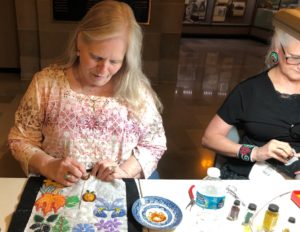
Cindy Jarrar (left) and Peggy Kinder work on applique beadwork samplers during Folk Arts at the Capitol in April 2019. Photo by Deborah A. Bailey
Together, Kinder and Jarrar have logged over 100 hours in the apprenticeship, where Jarrar created a beaded bandolier bag. Kinder has noted that, among its functions, Jarrar’s bag will serve as documentation or a “recording” of the traditional plantlore of their people. The apprentice plans to wear the beaded bag during upcoming Potawatomi ceremonies and powwows in Oklahoma and Kansas, immersing herself in their culture and sustaining it for future generations.
The heart of Missouri Folk Arts Program is its Traditional Arts Apprenticeship Program. Master artists work one-on-one with apprentices to keep folk arts knowledge and practices alive. In Missouri, with support from the National Endowment for the Arts, the Missouri Arts Council, and the University of Missouri, the first master-apprentice lesson took place on December 10, 1984. Since then, Missouri has supported over 400 apprenticeships in which 200+ master artists have mentored more than 500 apprentices in every region and many communities in the state. Many apprentices have in their turn grown in their artistry and later recognized as master artists in TAAP. They forge anew living links in the chain of Missouri’s folk arts. Some TAAP artists practice traditional regional crafts that date back to Missouri’s Native American peoples and early European settlers. Some newer immigrants, such as Latinxs, Sudanese, and Bosnians, have sustained their artistic traditions in their new homes in Missouri. Still more traditions have migrated to Missouri from other regions of the U.S. All are re-imagined and honed into dynamic Show Me State traditions. Among the arts that have been fostered in TAAP over the decades are blacksmithing, cowboy poetry, old-time short-bow fiddling, African-American storytelling, Ozark Riverways paddle carving, Vietnamese dragon dancing, Western saddle making, old-time clawhammer banjo, wood joinery, square dance calling, German bobbin lace, turkey calls, Mexican paper flowers, and Slovenian button-box accordion.
[Posted May 10, 2019 by Lisa L. Higgins]
Missouri Folk Arts, Focus Exhibit 2024
Thanks for visiting to learn more about Missouri Folk Arts and the Focus Exhibit!
Missouri Folk Arts is excited to curate a designated display case in our home at the University of Missouri’s Museum of Art & Archaeology in Columbia. Visitors will find the case just inside the accessible Hitt Street entrance on Ground Level East at Ellis Library across the street from Memorial Union.
In the case, visitors will find Potawatomi women’s leggings beaded by Peggy Hancock Kinder of Gladstone, Mo. and a dynamic photo collage.
The photo collage is but a small representation of Missouri Folk Arts’ participants and projects–from Show Me Folk‘s regional artist surveys to the Traditional Arts Apprenticeship Program and Missouri Arts Council Folk Arts grant-funded projects.
Below you’ll find descriptions of each image.
Row One
- Mary Barile (Boonville) and her 2023 apprentice Tina Edholm (Columbia) hold up Laundry Day, a hooked rug in progress. Edholm (left) designed the rug, referencing New Deal era photos, for their participation in Missouri’s Traditional Arts Apprenticeship Program (TAAP). In April 2024, Laundry Day won a best of show award at A Show of Hands, a special fiber arts exhibition during the Persimmon Creek Residences at Arrow Rock, Mo. Mary and Tina are members of the Big Muddy Rug Hookers in central Missouri. Photo credit: James Henderson.
- Arcola Quilting Club members (Dade County) work on a quilt top in 2022. From l to r: Cindy Brodie, Jackie Montgomery, Martha Alsup, and JoEtta Gleason. Kaitlyn McConnell of Ozarks Alive documented the quilting club, founded in 1939, for a Show Me Folk artist survey in the Ozarks. The Smithsonian Folklife Festival invited Martha and JoEtta to demonstrate quilting during the 2023 festival in celebration of the Ozarks. They invited all visitors to their tent to sit and add stitches to a beautiful purple and white quilt top. Their club finished the quilt, and it’s now in the permanent collection of Meyer Library at Missouri State University in Springfield.
- Ozark fiddlers Emily Garoutte (Springfield) and Nathan McAlister (Granby), a 2023 TAAP team, pause the to snap a photo in Taney County. They often join other musicians at the weekly McClurg Jam, a decades-old music party housed in a former general store. Nathan and Emily are also active with the non-profit Ozark Mountain Music, Inc., whose mission is to preserve and promote traditional music of the Ozarks for future generations. Photo credit: David Scrivner
Row Two
- Gospel artist Doris Frazier (Chesterfield) performs with a choir made up of family and church friends during a festival celebrating 30 years of the apprenticeship program. Frazier taught gospel piano and vocals in the TAAP’s inaugural year—1985. In 2022, her grandson produced a documentary film called Compositions of Life: Doris Fiddmont Frazier. That film chronicles her life story in Chesterfield and within the Union Baptist Church in historic Westland Acres. Photo credit: Lisa L. Higgins
- Latin Jazz musician Pablo Sanhueza first came to Missouri Folk Arts’ attention during a Show Me Folk artist survey in Kansas City, and then as a fellow partner in planning for Missouri Bicentennial celebrations. Pablo and Brandon Cooper, a 2020 TAAP team, perform with the Kansas City Latin Jazz Orchestra. Sanhueza is a prolific performing artist, who is dedicated to sustaining the South American traditional music he grew up with in Chile’. Photo credit: Cynthia Ammerman.
- Longtime Missouri Folk Arts’ partner Carmen Sofia Dence (St. Louis) performs a traditional dance from Barranquilla, Colombia, her birthplace, during the 2005 Festival of Nations in Tower Grove Park. Carmen founded Grupo Atlántico St. Louis in the 1990s, linking a community of Colombian and Latin American citizens who loved traditional dance and music. The Missouri Arts Council recognized Carmen’s artistry with a 2023 Individual Artist Award. Photo credit: Darcy Holtgrave
Row Three
- The late old-time fiddler Pete McMahan (Harrisburg) jams with other musicians in downtown Columbia, Mo. during a KOPN Community Radio event with the Missouri State Old-time Fiddlers Association. Pete regularly taught young fiddlers often in TAAP and at the Bethel Youth Fiddle Camp, now funded in part with a Missouri Arts Council Folk Arts grant. His album Ozark Mountain Waltz has been digitized and is available via the Missouri State Old Time Fiddlers Association. Photo archives at State Historical Society of Missouri, (C4035) University of Missouri-Columbia, Missouri Folk Arts Program Records
- Bernard Tappel, owner, and operator of the Osage Bluff Blacksmith Shop in Cole County, hammers out a fishing gig on his anvil. Tappel uses his gigs to fish on the nearby Maries River. Bernie has participated in the apprenticeship program, as well as served as an adviser on exhibitions, Missouri Bicentennial presentations, and the first year of the Show Me Folk artist surveys. He still demonstrates annually at the Missouri River Valley Steam Engine Association’s Show and is a founder of the Blacksmith Association of Missouri. Photo credit: Deborah A. Bailey
- Ripley County TAAP team Ernest “Uncle Punk” Murray (Doniphan) and his 1995 apprentice Steve Cookson work to carve a sassafras paddle. Paddles are used to navigate johnboats on the scenic Current River. In 2024, the Missouri State Museum included a paddle hand-crafted by Uncle Punk in its special exhibition Missouri Artists. Photo by Dana Everts-Boehm
Row Four
- Guru Prasanna Kasthuri, founder of Soorya Performing Arts in St. Louis, and his 2022 TAAP apprentice Saptheka Upadhya practice Bharatanatyam in the studio. Photo credit: Deborah A. Bailey
- Master Kore drummer Mulu Wani and 2014 TAAP apprentices perform during a lesson with the assistance of dancers at a Kansas City community center. Kore music and dance traditions, practiced by the South Sudanese immigrants, are intricately tied. Photo credit: Deborah A. Bailey
- Sugar Creek Slavic Fest, produced in part with a Missouri Arts Council Folk Arts grant, showcases local traditions–kola dances, tamburitza music, and foodways—brought to the greater Kansas City community over one hundred years ago. Photo credit: David Rainey
Missouri Folk Arts Program Joins National Marker Program Celebrating Folklore
COLUMBIA, Mo. February 25, 2020 — Intriguing stories from Missouri’s rich heritage of folklore will be featured on roadside markers at locations across the state thanks to a partnership between the Missouri Arts Council’s Missouri Folk Arts Program (MFAP) at University of Missouri and the William G. Pomeroy Foundation.

Established by the Pomeroy Foundation in 2015, the Legends & Lore program helps communities celebrate local folklore and legends with roadside markers. MFAP will serve as a grant evaluator for the Pomeroy Foundation’s expanding national Legends & Lore Marker Grant Program, helping to put Missouri folklore in the spotlight.
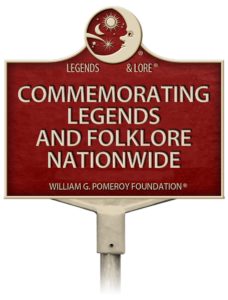
A sample “Legends & Lore” roadside marker
MFAP builds cross-cultural understanding by documenting, sustaining, and presenting the state’s living folk arts and folklife in collaboration with Missouri’s citizens. A partner of the Missouri Arts Council, a division of the Office of the Lieutenant Governor, MFAP is based at the Museum of Art and Archaeology at the University of Missouri.
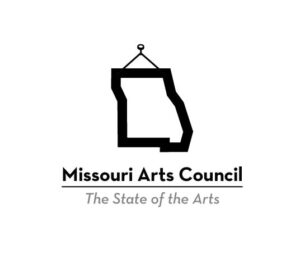
“We are excited to join colleagues across the country as a Legends & Lore state partner – and to be the first to represent the Midwest,” says Lisa L. Higgins, director of the Missouri Folk Arts Program. “Missouri’s bicentennial is just over a year away, and we’ve already witnessed an abundance of creative activities in anticipation of 2021. This is an inspiring time and we expect Legends & Lore will encourage local communities to mark the Show-Me state’s unique culture in an enduring way.”
The Pomeroy Foundation is a private grant-making foundation based in Syracuse, New York. The Foundation helps people celebrate their community’s history through a variety of historic roadside marker programs, including Legends & Lore. The Foundation’s grants cover the entire cost of a marker, pole, and shipping.
“The Pomeroy Foundation is pleased to partner with the Missouri Folk Arts Program on our expanding Legends & Lore program,” says Bill Pomeroy, founder and trustee of the Pomeroy Foundation. “We feel this is a wonderful opportunity to showcase the folklore near and dear to Missouri. We’re proud to work with your communities in celebrating and preserving your folklore and legends.”
As a Legends & Lore grant evaluator, MFAP will be responsible for reviewing applications, as well as confirming the legitimacy and accuracy of folklore and legends that applicants in Missouri intend to commemorate on a marker. Legends & Lore marker grants are available to 501(c)(3) organizations, nonprofit academic institutions, and local, state, and federal government entities in Missouri. Grant applicants may submit during two application windows in 2020. Grant Round 1 opens on Monday, March 23, 2020; application deadline is Friday, May 1, 2020. Grant Round 2 opens on Monday, Aug. 17, 2020; application deadline is Friday, Oct. 2, 2020.
The Pomeroy Foundation has funded more than 70 Legends & Lore roadside markers to commemorate fascinating local stories. One of those markers celebrates Ichabod Crane and “The Legend of Sleepy Hollow.” It’s said that this famous Washington Irving character was based on a real schoolteacher named Jesse Merwin in Kinderhook, New York. Another example is a Legends & Lore marker located Talcott, West Virginia, recognizing the folk hero John Henry and the famed story of his race against a steam drill.
For program details and how to apply, visit wgpfoundation.org/history/legends-lore.
About the Missouri Folk Arts Program
The Missouri Folk Arts Program (MFAP) is a program of the Missouri Arts Council, a division of the Office of the Lieutenant Governor, and the Museum of Art and Archaeology at Missouri’s flagship university campus. Established in 1984, MFAP builds cross-cultural understanding by documenting, sustaining, and presenting our state’s living folk arts and folklife in collaboration with Missouri’s citizens. One of over 40 state programs around the United States, MFAP has provided programs and services to traditional artists, organizations, and their local communities for over three decades. MFAP is funded through the University, grants from the Missouri Arts Council and National Endowment for the Arts, as well as individual donors. mofolkarts.missouri.edu
About the Pomeroy Foundation
The William G. Pomeroy Foundation is a private, grant-making foundation established in 2005. The Foundation is committed to supporting the celebration and preservation of community history; and to raising awareness, supporting research and improving the quality of care for patients and their families who are facing a blood cancer diagnosis. To date, the Foundation has awarded more than 1,000 roadside markers and plaques nationwide. wgpfoundation.org
# # #
CONTACT: Lisa L. Higgins, director, HigginsLL@missouri.edu, 573-882-6296, mofolkarts.missouri.edu

